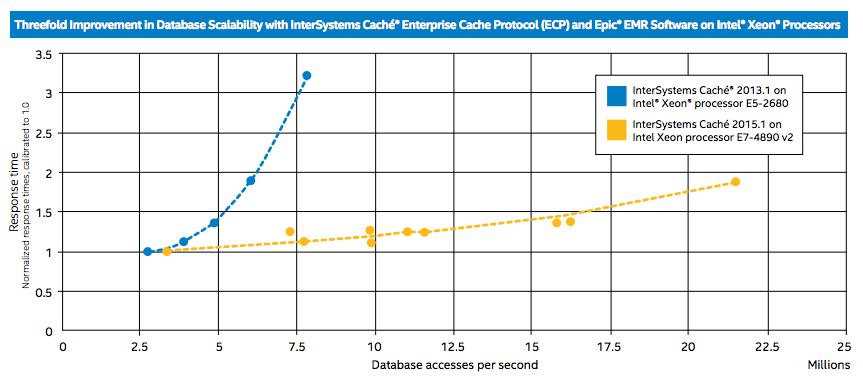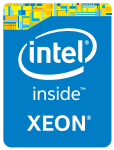Caché 2015 Scalability with Ivy Bridge-EX
Recently, we talked about the latest release of InterSystems Caché 2015.1 , which significantly improved performance, supported the second version of the XSL Transformations (XSLT) Version 2.0 XML document transformation language, and used semaphores to synchronize processes in Caché and organize their interaction with each other. In addition, the new Caché release expands the use of high-availability scripts and supports the use of an external NGINX web server for the Caché application server. In this article, we’ll talk about the first of these enhancements to our database, namely, how much Caché’s performance improves on multiprocessor servers equipped with Intel Xeon E7 v2 processors (codenamed Ivy Bridge-EX).

These processors, which are the most powerful in the Intel Xeon line and designed for four or more processor systems, came out about a year ago. Compared to the first generation Xeon E7, they doubled the performance, increased the internal cache by 25%, tripled the maximum amount of RAM supported and quadrupled the I / O bandwidth. In addition, through the use of crash protection technologies designed for Intel Itanium processors, servers based on Xeon E7 v2 provide accessibility at the level of five nines (99.999%). The Xeon E7 processor contains up to 15 processor cores, which support two command streams, and use shared L3 cache with up to 37.5 MB and up to three QuickPath Interconnect (QPI) links. Four-processor servers equipped with this processor are scaled to 6 TB of RAM, and eight-processor servers to 12 TB of RAM.
In order to evaluate the scalability of Caché 2015.1 using Xeon E7 v2 processors, InterSystems has tested the database while maintaining the Electronic Medical Records Management System (EMR) from EPIC , which is used in some of the largest US medical institutions. Tests have shown that Caché 2015.1 combined with Enterprise Cache Protocol (ECP) technology on Xeon E7 v2-based servers can handle more than 21 million end-user requests to the database per second (we call this Global References per Second or GREF) . In this case, more than three times the result was improved, which was achieved on Caché 2013.1 in combination with the Xeon E5. The choice to test the EMR system is explained by the fact that medical institutions along with financial institutions, retail and the public sector are the main customers of InterSystems.
')
The three-fold increase in productivity was achieved due to the following improvements in the scalability of Caché 2015.1:
The tests were performed using a copy of a real multi-terabyte database, which is used by the EPIC EMR system serving the Sanford Health hospital network. Sanford Health is one of the largest medical organizations in the United States, which owns 43 hospitals with 1,400 doctors, and provides treatment for more than 26,000 patients.
Intersystems and Epic performance experts performed on a multi-terabyte copy of the Sanford Health database a series of tests to determine Caché 2015.1 performance measured in GREF, and also tested the performance of the same database with the previous release of Caché 2013.1. To generate the load generated by database queries from end users, special modeling tools developed by Epic were used. At the same time, the number of end users accessing the database gradually increased. In the tests, both the GREF performance indicators and the delay values were measured, i.e. how fast the database can handle a series of complex queries.
 For testing, Caché 2015.1 used a four-processor server with Intel Xeon E7-4890 v2 processors with a clock frequency of 2.8 GHz, and Caché 2013.1 worked on a two-socket server with Intel Xeon E5-2680 2.7 GHz. Both servers were running Red Hat Enterprise Linux and VMware vSphere; they had the necessary resources of computing power, RAM and disks, so that these indicators did not limit the scalability of the systems or slow down the database's response to requests. A solid state array was used as a storage system.
For testing, Caché 2015.1 used a four-processor server with Intel Xeon E7-4890 v2 processors with a clock frequency of 2.8 GHz, and Caché 2013.1 worked on a two-socket server with Intel Xeon E5-2680 2.7 GHz. Both servers were running Red Hat Enterprise Linux and VMware vSphere; they had the necessary resources of computing power, RAM and disks, so that these indicators did not limit the scalability of the systems or slow down the database's response to requests. A solid state array was used as a storage system.
As can be seen from the graph, Caché 2015.1 on a server with Intel Xeon E7-4890 v2 in tests showed three times better performance than Caché 2013.1 on a server with Intel Xeon E5-2680. The graph also clearly demonstrates that with an increase in the number of queries to the database, the delays in using the new Caché release grow much slower. It should be noted that testing with more than 22 million GREF was not conducted due to limitations in the server's hardware configuration, and not to achieve the performance ceiling of Caché 2015.1 itself.
Testing demonstrated significantly improved scalability of the new Caché release, provided both with improvements in the database parallelization mechanism and using the advantages of the new multi-core architecture of Intel Xeon E7 v2 processors.
Thank you for your attention, we are ready to answer your questions.

These processors, which are the most powerful in the Intel Xeon line and designed for four or more processor systems, came out about a year ago. Compared to the first generation Xeon E7, they doubled the performance, increased the internal cache by 25%, tripled the maximum amount of RAM supported and quadrupled the I / O bandwidth. In addition, through the use of crash protection technologies designed for Intel Itanium processors, servers based on Xeon E7 v2 provide accessibility at the level of five nines (99.999%). The Xeon E7 processor contains up to 15 processor cores, which support two command streams, and use shared L3 cache with up to 37.5 MB and up to three QuickPath Interconnect (QPI) links. Four-processor servers equipped with this processor are scaled to 6 TB of RAM, and eight-processor servers to 12 TB of RAM.
In order to evaluate the scalability of Caché 2015.1 using Xeon E7 v2 processors, InterSystems has tested the database while maintaining the Electronic Medical Records Management System (EMR) from EPIC , which is used in some of the largest US medical institutions. Tests have shown that Caché 2015.1 combined with Enterprise Cache Protocol (ECP) technology on Xeon E7 v2-based servers can handle more than 21 million end-user requests to the database per second (we call this Global References per Second or GREF) . In this case, more than three times the result was improved, which was achieved on Caché 2013.1 in combination with the Xeon E5. The choice to test the EMR system is explained by the fact that medical institutions along with financial institutions, retail and the public sector are the main customers of InterSystems.
')
The three-fold increase in productivity was achieved due to the following improvements in the scalability of Caché 2015.1:
- A new paralleling algorithm for certain applications, thanks to which with increasing load and the number of users the application response time remains at the same level;
- Caché 2015.1 uses special commands that minimize latency when running applications on multi-core systems associated with non-uniform data access (NUMA, non-uniform memory access), therefore, as the number of processors installed on the processor servers increases, the application response time does not increase.
How tests were conducted
The tests were performed using a copy of a real multi-terabyte database, which is used by the EPIC EMR system serving the Sanford Health hospital network. Sanford Health is one of the largest medical organizations in the United States, which owns 43 hospitals with 1,400 doctors, and provides treatment for more than 26,000 patients.
Intersystems and Epic performance experts performed on a multi-terabyte copy of the Sanford Health database a series of tests to determine Caché 2015.1 performance measured in GREF, and also tested the performance of the same database with the previous release of Caché 2013.1. To generate the load generated by database queries from end users, special modeling tools developed by Epic were used. At the same time, the number of end users accessing the database gradually increased. In the tests, both the GREF performance indicators and the delay values were measured, i.e. how fast the database can handle a series of complex queries.
 For testing, Caché 2015.1 used a four-processor server with Intel Xeon E7-4890 v2 processors with a clock frequency of 2.8 GHz, and Caché 2013.1 worked on a two-socket server with Intel Xeon E5-2680 2.7 GHz. Both servers were running Red Hat Enterprise Linux and VMware vSphere; they had the necessary resources of computing power, RAM and disks, so that these indicators did not limit the scalability of the systems or slow down the database's response to requests. A solid state array was used as a storage system.
For testing, Caché 2015.1 used a four-processor server with Intel Xeon E7-4890 v2 processors with a clock frequency of 2.8 GHz, and Caché 2013.1 worked on a two-socket server with Intel Xeon E5-2680 2.7 GHz. Both servers were running Red Hat Enterprise Linux and VMware vSphere; they had the necessary resources of computing power, RAM and disks, so that these indicators did not limit the scalability of the systems or slow down the database's response to requests. A solid state array was used as a storage system.results
As can be seen from the graph, Caché 2015.1 on a server with Intel Xeon E7-4890 v2 in tests showed three times better performance than Caché 2013.1 on a server with Intel Xeon E5-2680. The graph also clearly demonstrates that with an increase in the number of queries to the database, the delays in using the new Caché release grow much slower. It should be noted that testing with more than 22 million GREF was not conducted due to limitations in the server's hardware configuration, and not to achieve the performance ceiling of Caché 2015.1 itself.
findings
Testing demonstrated significantly improved scalability of the new Caché release, provided both with improvements in the database parallelization mechanism and using the advantages of the new multi-core architecture of Intel Xeon E7 v2 processors.
Thank you for your attention, we are ready to answer your questions.
Source: https://habr.com/ru/post/257501/
All Articles